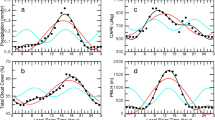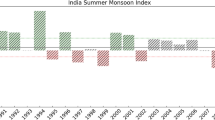Abstract
Many studies have investigated the effects that misrepresentation of sub-grid cloud structure can have on the radiation budget. In this study, we perform 20-year simulations of the current climate using an atmosphere-only version of the Met Office Unified Model to investigate the effects of cloud approximation on model climate. We apply the “Tripleclouds” scheme for representing horizontal cloud inhomogeneity and “exponential-random” overlap, both separately and in combination, in place of a traditional plane-parallel representation with maximum-random overlap, to the clouds within the radiation scheme. The resulting changes to both the radiation budget and other meteorological variables, averaged over the 20 years, are compared. The combined global effect of the parameterizations on top-of-atmosphere short-wave and long-wave radiation budget is less than 1 W m−2, but changes of up to 10 W m−2 are identified in marine stratocumulus regions. A cooling near the surface over the winter polar regions of up to 3°C is also identified when horizontal cloud inhomogeneity is represented, and a warming of similar magnitude is found when exponential-random overlap is implemented. Corresponding changes of the same sign are also found in zonally averaged temperature, with maximum changes in the upper tropical troposphere of up to 0.5°C. Changes in zonally averaged cloud fraction in this location were of opposite sign and up to 0.02. The individual effects on tropospheric temperature of improving the two components of cloud structure are of similar magnitudes to about 2% of the warming created by a quadrupling of carbon dioxide.











Similar content being viewed by others
References
Barker HW (2008) Overlap of fractional cloud for radiation calculations in GCMs: a global analysis using CloudSat and CALIPSO data. J Geophys Res 113:doi:10.1029/2007JD009
Barker HW, Stephens GL, Fu Q (1999) The sensitivity of domain-averaged solar fluxes to assumptions about cloud geometry. Q J R Meteorol Soc 125:2127–2152
Bender FA, Rodhe H, Charlson RJ, Ekman AML, Loeb N (2006) 22 views of the global albedo—comparison between 20 GCMs and two satellites. Tellus 58A:320–330
Brown PRA, Francis PN (1995) Improved measurements of the ice water content in cirrus using a total-water probe. J Atmos Oceanic Technol 12:410–414
Cahalan RF, Ridgway W, Wiscombe WJ, Bell TL, Snyder JB (1994) The albedo of fractal stratocumulus clouds. J Atmos Sci 51:2434–2455
Carlin B, Fu Q, Lohmann U, Mace GG, Sassen K, Comstock JM (2002) High-cloud horizontal inhomogeneity and solar albedo bias. J Clim 15:2321–2339
Edwards JM, Slingo A (1996) Studies with a flexible new radiation code. Part I: choosing a configuration for a large-scale model. Q J R Meteorol Soc 122:689–719
Geleyn JF, Hollingsworth A (1979) An economical, analytical method for the computation of the interaction between scattering and line absorption of radiation. Contribut Atmos Phys 52:1–16
Hogan RJ, Illingworth AJ (2000) Deriving cloud overlap statistics from radar. Q J R Meteorol Soc 126:2903–2909
Martin GM, Bellouin N, Collins WJ, Culverwell ID, Halloran PR, Hardiman SC, Hinton TJ, Jones CD, McDonald RE, McLaren AJ, O’Connor FM, Roberts MJ, Rodriguez JM, Woodward S, Best MJ, and Co-authors (2011) The HadGEM2 family of Met Office Unified Model climate configurations. Geoscientif Model Dev Discuss 4:765–841
Oreopoulos L, Barker HW (1999) Accounting for sub-gridscale cloud variability in a multi-layer 1D solar radiative transfer algorithm. Q J R Meteorol Soc 125:301–330
Pincus R, Barker HW, Morcrette J (2003) A fast, flexible, approximate technique for computing radiative transfer in inhomogeneous cloud fields. J Geophys Res 108:doi:10.1029/2002JD003
Pomroy HR, Illingworth AJ (2000) Ice cloud inhomogeneity: quantifying bias in emissivity from radar observations. Geophys Res Lett 27:2101–2104
Potter GL, Cess RD (2004) Testing the impact of clouds on the radiation budgets of 19 atmospheric general circulation models. J Geophys Res 109:doi:10.1029/2003JD004
Ramanathan V, Cess RD, Harrison EF, Minnis P, Barkstrom BR, Ahmad E, Hartmann DL (1989) Cloud radiative forcing and climate: results from the Earth Radiation Budget Experiment. Science 243:57–63
Randall DA, Wood RA, Bony S, Colman R, Fichefet T, Fyfe J, Kattsov V, Pitman A, Shukla J, Srinivasan J, Stouffer RJ, Sumi A, Taylor KE (2007) Climate Change 2007: the Physical Science Basis. Contribution of Working Group I to the Fourth Assessment Report of the Intergovernmental Panel on Climate Change, Cambridge University Press, chap 8: “Climate models and their evaluation”
Shonk JKP, Hogan RJ (2008) Tripleclouds: an efficient method for representing cloud inhomogeneity in 1D radiation schemes by using three regions at each height. J Clim 21:2352–2370
Shonk JKP, Hogan RJ (2010) Effect of improving representation of horizontal and vertical cloud structure on the Earth’s global radiation budget. Part II: the global effects. Q J R Meteorol Soc 136:1205–1215
Shonk JKP, Hogan RJ, Mace GG, Edwards JM (2010) Effect of improving representation of horizontal and vertical cloud structure on the Earth’s global radiation budget. Part I: review and parametrisation. Q J R Meteorol Soc 136:1191–1204
Slingo A (1990) Sensitivity of the Earth’s radiation budget to changes in low clouds. Nature 343:49–51
Stephens GL (2005) Cloud feedbacks in the climate system: a critical review. J Clim 18:237–273
Wexler H (1937) Formation of polar anticyclones. Monthly Weather Rev 65:229–236
Acknowledgments
We thank the following people at the Met Office for their help, support and advice: Jon Petch, Cyril Morcrette, Dan Copsey, Jonathan Wilkinson, Peter Hill, Terry Davies, David Hassell, Khalid Mahmood and Andy Macallan. We also thank Keith Shine for some very useful discussions, Loïs Steenman-Clark for advice on getting started with the Unified Model, and Ed Hawkins for help with CMIP5 data. This work was supported by NERC grants NE/F011261/1 and NE/G016038/1.
Author information
Authors and Affiliations
Corresponding author
Rights and permissions
About this article
Cite this article
Shonk, J.K.P., Hogan, R.J. & Manners, J. Impact of improved representation of horizontal and vertical cloud structure in a climate model. Clim Dyn 38, 2365–2376 (2012). https://doi.org/10.1007/s00382-011-1174-2
Received:
Accepted:
Published:
Issue Date:
DOI: https://doi.org/10.1007/s00382-011-1174-2




